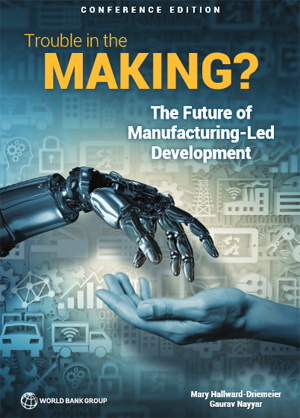Advances in technology and changing trade patterns are affecting opportunities for export-led manufacturing. Smart automation, advanced robotics and 3-D printing are new factors influencing which locations are attractive for production. While these shifts threaten significant disruptions in future employment, particularly for low-skilled workers, they also offer opportunities, according to a new report released today by the World Bank Group. 
The report, Trouble in the Making? The Future of Manufacturing-Led Development, underscores the resulting changes in the manufacturing sector’s ability to create jobs and lift people out of poverty in developing countries. It encourages policymakers to adjust their approach to spurring job creation in manufacturing and readying workers for the jobs of the future.
“Technology and globalization are changing how manufacturing contributes to development. We will need to embrace this change rather than fear it. In the past, the manufacturing sector created jobs for unskilled workers and increased productivity. In the future, developing countries will need to update their policies along with their infrastructure, firm capabilities and job creation strategies to meet the demands of a more technologically advanced world,” stated Anabel Gonzalez, the World Bank Group’s Senior Director for Trade & Competitiveness.
Changing technologies and shifting globalization patterns are destined to reshape manufacturing-led development strategies, according to the report. Trade is slowing. Global value chains remain concentrated among a relatively small number of countries. Smart automation, advanced robotics, 3-D printing and other advances being incorporated by global manufacturers of cars, electronics, apparel, consumer and other goods are shifting how countries and firms compete for production.
While these trends raise fears that manufacturing will no longer offer an accessible pathway to growth for low- and middle-income countries, the report seeks to identify policy priorities that can help these economies face the challenges and embrace the opportunities they bring.
“Countries can seize promising new opportunities for productivity growth and job creation if policymakers pursue approaches that adapt to changing technologies and changing patterns of globalization,” stated Mary Hallward-Driemeier, a Senior Economic Advisor in the World Bank Group’s Trade & Competitiveness Global Practice and the report’s co-author. “Those countries that don’t are likely to face not just economic costs, but also social costs associated with increased inequality and more limited access to opportunities.”
The report offers “3Cs” for countries seeking to bolster their manufacturing sectors: competitiveness, capabilities and connectedness.
- Ensuring competitiveness will increase the importance of reforms that reduce unit-labor costs. But it will also require each economy to be better able to consider new business models; to seek new contracting relationships that embrace new technologies; and to devise new ways for manufactured goods to also deliver services.
- Building capabilities will involve giving workers new sets of skills, strengthening firms’ abilities to absorb new technologies, and providing new infrastructure and new rules to support the use of new technologies.
- Promoting connectedness will continue to emphasize openness to trade in goods, including raw materials and components. But it also increases the importance of grasping the synergies with services that are increasingly embodied and embedded within manufactured goods.
“New processes and new technologies will change how traditional goods are made,” said Gaurav Nayyar, an Economist in the World Bank Group’s Trade & Competitiveness Global Practice and the report’s co-author. “To make the most of each economy’s potential, policymakers and private-sector decision-makers will need to seize new opportunities by re-thinking their manufacturing-led development strategies.”
Information provided by the World Bank Group; the entire report may be downloaded as a PDF here.
Related Glossary Terms
- 3-D
3-D
Way of displaying real-world objects in a natural way by showing depth, height and width. This system uses the X, Y and Z axes.
- robotics
robotics
Discipline involving self-actuating and self-operating devices. Robots frequently imitate human capabilities, including the ability to manipulate physical objects while evaluating and reacting appropriately to various stimuli. See industrial robot; robot.
